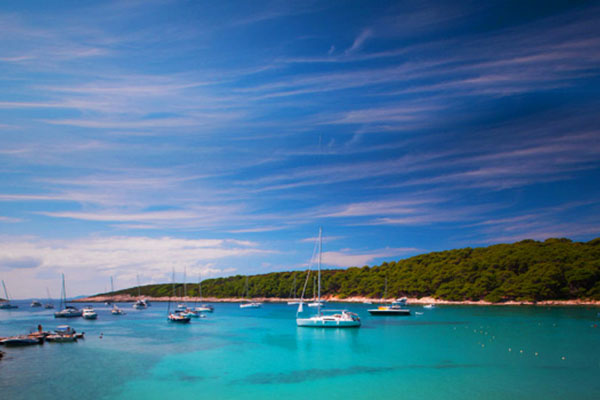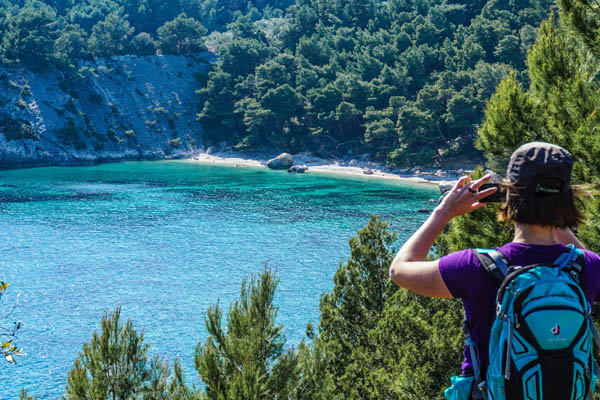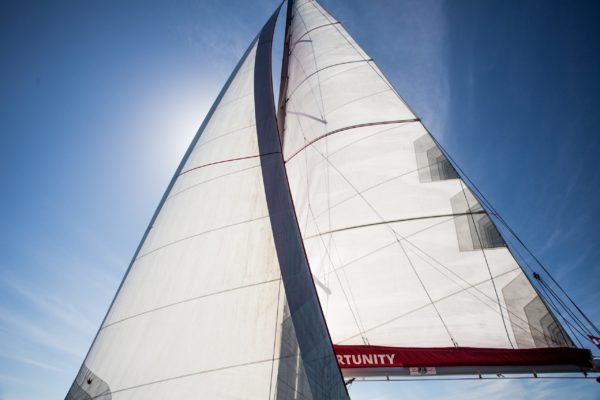Explore Croatia
Korčula Island
Explore Korcula Island & Town
The island of Korcula is one of the most popular island destinations in Croatia. Not only is this considered to be the birthplace of one of the most notable travelers, Marco Polo (who impacted many adventurers—including Christopher Columbus!—to sail off and explore the world) but it’s a favorite during the summer season when the number of people on the island increases exponentially.
The island welcomes its visitors with open arms, eager to show and share its natural, gastronomical, and historical heritage. It’s a popular stop on a longer Croatia trip from Dubrovnik, to Korcula, to Brac, and on to Split.
Korčula Town: Situated on the island’s east side coast, Korčula Town is the main town on the island, with a population of about 2600 inhabitants. Its popular name is ‘Little Dubrovnik,’ as a wonderfully romantic promenade runs around the town by the city walls. Its little alleys around the main street and the square are in the shape of a fishbone to serve as natural air conditioning regulating the wind flow, while its walls protect it from winter stormy and cold winds. In addition, Korčula also boasts towers, numerous buildings and monuments, cafés, restaurants, hotels, galleries, open-air cinema, and more. It is an excellent location from which you can explore the rest of the island and its surroundings.
Korčula Inland from the Coast: You might be surprised, but some of the most beautiful things to see on Korcula island are not even close to the sea! Its inland is full of picturesque villages like, for example, Čara and Smokvica. Both villages have been inhabited since prehistoric times, evidenced by the numerous remains of antique ceramics, centuries-old vineyards, old rustic villas, Medieval churches, and Korčula noble castles. The villages are best known for being the cradle of Pošip, a famous Croatian white wine.
The island has been inhabited since prehistoric times with the archeological remains found in Vela Spila cave dating back to the Old Stone Age. Throughout the centuries Korčula has been under the control of a flurry of civilizations all shaping the landscape and culture of the island, from the Illyrians to the Greeks, Venetians, and Austrians.
1. The Cathedral of St. Mark’s
The Cathedral of St. Mark’s is a Gothic-Renaissance building made by local masters and craftsmen in the 15th century. It houses ‘Pieta’ by Ivan Meštrović and Jesus Christ the Redeemer by Frano Kršinić. Another Meštrović’s work, the statue of St. Blasius is situated near the entrance to the sacristy. Inside the Cathedral there are two Tintoretto’s paintings.
2. Vela Luka
Vela Luka is located on the western side of the Island of Korčula at the bottom of a wide bay that has many indented coves. In the past, Vela Luka was known as a town of farmers, traders, shipbuilders, and fishermen. The diversity and richness of the cultural inheritance of this charming Mediterranean port town can be seen in its exceptional museums and galleries. It is absolutely worth taking an inspiring stroll through the town’s interesting history.
3. The Caves of Korčula
Korčula has many caves. The composition of the island is nearly all rock and to be more specific: limestone, marl, and dolomite. A landscape made up of these rocks is known as a karst landscape as water on its own, or slightly acidic water erodes the stone through time. This is what has happened to Korcula and why there are so many caves.
The two most impressive and well-known caves are Vela Spila (big cave) in Vela Luka and Samograd Spila in Racisce. Of these two, Vela Spila is better known and easily accessible. It is located on the southern side of Pinski Rat Mountain, 130 m above sea level, and is one of the most important prehistoric archaeological localities in Europe. Excavations and the archaeological investigation of the site lead to the conclusion that the cave has been continuously inhabited since the early Stone Age (about 20 000 bc), and there is evidence of an occasional human presence in the following periods – Iron Age and Copper Age. To this day it has been used by the Greeks, the Romans, the Byzantines and many others.
4. Lumbarda Vineyards & Sandy Beaches
Lumbarda is a small fishermen’s village east of Korčula town, It is built around a small bay and on the mild hills behind it. Inhabited since ancient times and rich in history, it is surrounded by vineyards and sandy beaches, and it is home to Grk; an indigenous grape sort originating from the Greek era (thus the name) and existing only in Lumbarda due to the particular terroir of its vineyards.
A visit to Korčula island is not complete without joining a wine-tasting tour. The island is abundant with family-run wineries and where you can sample the best of the island’s wines. The island is famous for autochthonous white grape varieties of Pošip and Grk.
5. Kočje
Kocje is a labyrinth of strangely shaped dolomite rocks overgrown with ivy, surrounded by holm oak, ferns, and other flora. They are interwoven in a most delicate way with cave-like spaces between the rocks dressed in moss seemingly hiding some primordial secrets. Local myths and legends still claim that there are fairies living around there. It was signed in the Register of Protected Nature Facilities of the Republic of Croatia in 1962.
6. Korčula Archipelago
Korčula Archipelago, also known as Škoji islands, is a group of 20 islands, islets and rocks lying off the coast between Korčula and Lumbarda. The islands are a favorite day-trip destination for both locals and visitors alike. The islands are home to numerous wonderful beaches, hidden coves and wonderful spots for swimming and snorkeling.
7. Korčula Quarries
Numerous old quarries can be found around Korčula island. The one at Vrnik, an islet situated between Lumbarda and Korčula town, is the oldest and most famous quarry. The quarry was used since ancient Roman times, and the high-quality limestone from Korčula is incorporated into numerous beautiful buildings not only in Croatia but around the whole European continent.
let's go there!
Popular Tours to Korcula Island & Town
what our guests say
Korčula Croatia FAQs
The origin of the island’s name derives from the Greek name, Corkyra Melaina: the first Greeks to find it named it “Corkyra” for the name of their own island, and “Melaina” which means black or dark-skinned because they were in awe of the dense forests covering the hills. Another name you might hear is Black Corfu.
This island and town offer a host of activities. Popular ones include sea kayaking, cycling, hiking, wine and food tasting tours—and, of course, sailing!
Did you know...
All the streets in Korcula Old Town have stairs, except for one which is locally known as the “Street of Thinkers.”
Related Blog Posts
Sailing in Croatia – Insider Tips on What You Need to Know
What Sailing in Croatia is Like – Insider Tips Sailing …
Kayaking the Adriatic sea
Recollection to one of the most memorable experiences in my life – the sea kayaking expedition across the Adriatic from Croatia to Italy.















